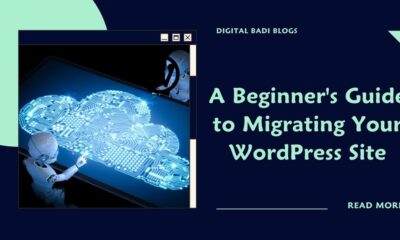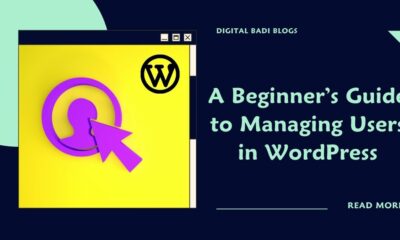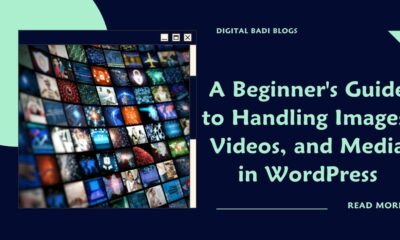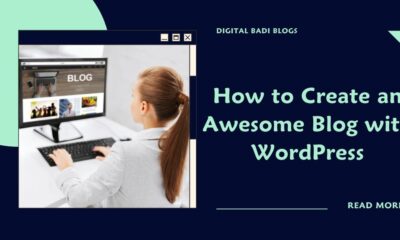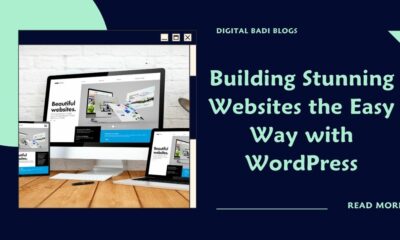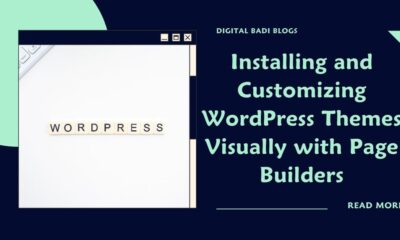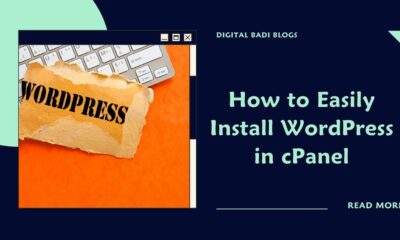WordPress
What is WordPress? A Beginner’s Guide to Understanding the Popular CMS
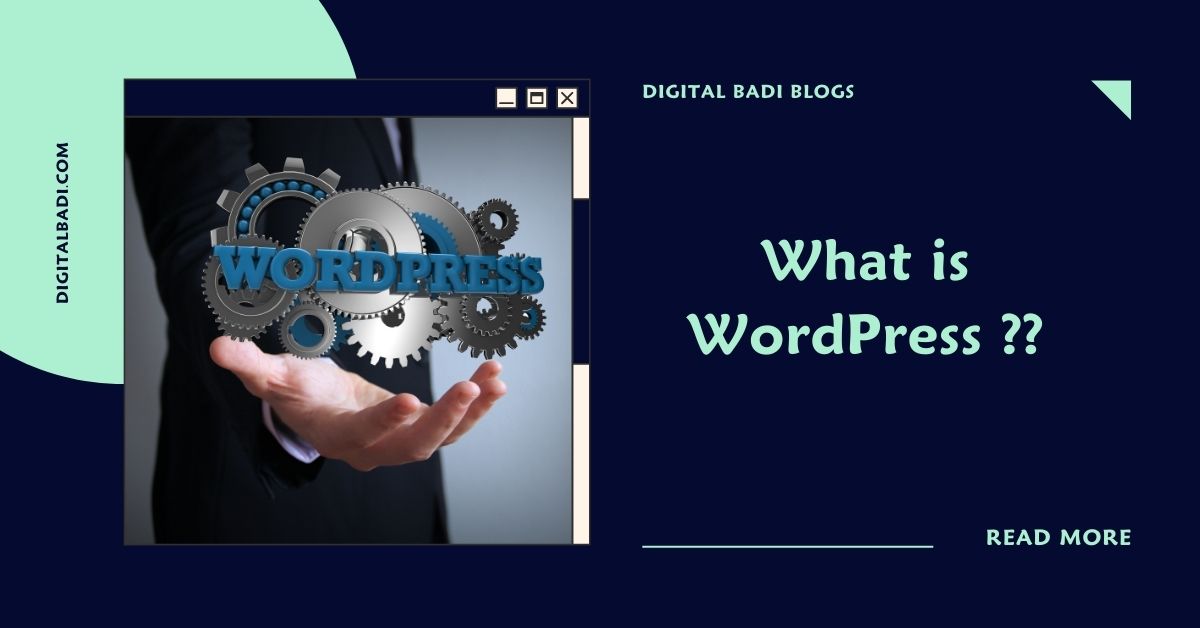
Table of Contents
What is WordPress? A Beginner’s Guide to Understanding the Popular CMS
If you spend any time browsing websites, there’s a good chance you’ve encountered WordPress without even realizing it. From personal blogs to major news outlets, WordPress powers over 40% of sites on the web. Yet with this huge adoption, some internet users still ask the question – what is WordPress exactly?
In this beginner’s guide, I’ll explain exactly what WordPress is, why it’s so widely used, who can benefit from using it, and much more. Whether you’re looking to create your first website or are just curious about the platform, read on to see why WordPress is one of the web’s most popular open source projects.
Defining WordPress – Content Management System
What is WordPress:- Is free, open source software that allows users to easily build and design websites and blogs without needing to code. It serves as a content management system (CMS) that organizes and manages website content through an intuitive dashboard interface.
With WordPress handling the backend technical tasks, users can focus on creating great site content and customizing the design. It empowers anyone, from total beginners to experienced developers, to bring their web ideas to life.
Originally launched in 2003 as a simple blogging platform, WordPress has evolved to become a full-featured CMS used by top companies, bloggers, agencies, universities, nonprofits, and more. Beyond basic websites and blogs, WordPress powers advanced applications like:
- Ecommerce stores
- Membership sites
- Learning management systems
- Social networking sites
- Publishing platforms
Yet with all this flexibility, using WordPress doesn’t require coding knowledge or technical expertise. Its user-friendly approach, backed by a huge community support network, makes WordPress accessible to users of all skill levels.
Below I’ll explore the core capabilities and components that make WordPress such a powerful web development tool.
Key WordPress Features and Benefits
What can you achieve by using WordPress? Here are some of the key features and benefits:
Easy Content Creation and Management
At its heart, WordPress enables users to quickly publish and organize content without HTML or coding knowledge. The dashboard provides an intuitive editor to create and format posts and pages. Built-in media management tools make it easy to handle images, videos, docs, and more.
With everything housed in one place, websites built on WordPress are simple to maintain. You can instantly update content, handle menus and navigation, manage users, and more from the admin dashboard.
Search Engine Optimization
WordPress sites also provide great search engine optimization (SEO) right out of the box. Useful features include:
- Custom URLs for posts and pages
- XML sitemaps for indexing
- Social media integration
- Responsive design for all devices
- Fast performance with caching plugins
- SEO-friendly content editors
These capabilities allow WordPress sites to rank well in Google and other search engines with some optimization effort.
Extensive Theme and Plugin Ecosystem
Thousands of free and premium WordPress themes and plugins exist to add features, customize design, improve SEO, handle security, and more. Top plugins like Yoast SEO, WooCommerce, and Contact Form 7 are used on millions of sites.
This extensive ecosystem allows you to easily extend WordPress’s functionality to create versatile websites from blogs to online stores.
Open Source Community
As open source software, WordPress benefits from constant collaboration and innovation from contributors globally. If you have web development skills, you can get involved to help improve WordPress for everyone.
The open source model fosters a spirit of sharing – the WordPress community provides documentation, forums, and support to help others. Conferences and meetups unite WordPress users worldwide.
Accessibility and Localization
With a goal to be accessible to all users, WordPress sites support WCAG and ADA compliance. Built-in features like alt text make images accessible. Plus, WordPress has been translated into over 60 languages for localization.
Mobile Responsive
All WordPress sites are designed using responsive standards to provide an optimal viewing experience on any device, whether desktop or mobile. No extra work is required to make your site mobile-friendly.
Flexibility and Scalability
WordPress can be used for both simple websites and complex web applications. The platform is scalable to support higher traffic volumes with some configuration. Many large web entities from CNN to PlayStation use WordPress to power their online presence.
Security
While no platform is 100% secure, WordPress core updates regularly to address vulnerabilities. Security plugins like Wordfence provide additional protection against threats. With some diligence, WordPress sites can be made highly secure.
Low Cost
Hosting and managing a WordPress site is very affordable, even for high traffic sites. Shared hosting plans for WordPress start around $5/month. Popular free themes and plugins further reduce costs versus custom development.
With all these useful features and benefits, it’s easy to see why WordPress has become the world’s #1 CMS and continues growing. The platform empowers practically anyone to build professional websites regardless of technical skill level.
WordPress Architecture and Components
Now that we’ve covered the capabilities of WordPress at a high level, let’s look under the hood and explore its underlying architecture and components. Understanding how WordPress works can help you use it more effectively.
The Loop
The key to WordPress’s functionality is the “Loop”. This is the PHP code that queries posts from the database and displays them. It allows you to dynamically pull and show content on web pages.
The Loop runs on every homepage, blog posts index, category, archive, search etc. It’s what makes your content dynamic instead of static HTML. Mastering use of the Loop allows you to customize what content WordPress displays and how.
Templates
Templates control the styling and structure of content displayed by the Loop. Every WordPress theme consists of a set of templates to define the appearance of various pages.
For example, the “single.php” template controls the design and layout of single blog posts, while “page.php” handles pages. Templates utilize HTML markup, CSS styling, and PHP code to output content.
Plugins
Plugins allow extending WordPress’s features and functionality beyond the core platform. The expansive plugin library includes options like ecommerce, SEO, social media, security, commenting, forms, and more.
Plugins run PHP code to alter how WordPress works. They can integrate external APIs, create custom post types, set up login systems, import/export data, and much more.
Widgets
Widgets enable inserting content blocks into sidebars and other widget areas defined by themes. For example, widgets allow displaying recent posts, custom menus, embedded video, advertisements, social icons, and similar features.
Hooks and Filters
Hooks and filters provide ways to tap into WordPress to modify its behavior without altering core files. They allow plugins and themes to hook into key events and functions.
For example, hooks tied to publishing posts allow plugins to add meta tags, ping services, or trigger other actions when content is published. Filters modify content as it is outputted.
Rest API
The WordPress REST API allows external applications to interact with WordPress sites by sending and receiving data as JSON. It enables building custom mobile or desktop apps powered by your WordPress data.
Block Editor
The block editor (Gutenberg) introduced in WordPress 5.0 allows organizing post and page content using blocks. It provides an improved editing experience and site building capabilities.
This has been a high-level look at key elements that power WordPress functionality including the Loop, templates, plugins, hooks/filters, and more. Now let’s look at how you can get started with WordPress.
Getting Started With WordPress
One of the great things about WordPress is how quick and easy it is to get started. Here is an overview of what’s involved:
Find Web Hosting
Like any website, you’ll need web hosting for your WordPress site. Many budget friendly options exist starting around $5/month. Top WordPress hosts like Bluehost offer 1-click WordPress installation.
Install WordPress
Installation of WordPress core files takes just a few minutes through an auto-installer from your hosting provider. You can also manually upload WordPress for more control.
Choose a Theme
Themes control how your site looks and functions. Thousands of free and paid themes offer designs for blogs, businesses, magazines, and more. Popular picks include Astra, GeneratePress, OceanWP, and Sydney.
Install Essential Plugins
Plugins add key functionality not part of core WordPress. For basics, install an SEO plugin like Yoast, security like Wordfence, and caching like WP Fastest Cache.
Create Content
Start publishing pages and blog posts through the user-friendly admin dashboard. Add text, images, videos and other media. Structure content within categories for better organization.
Manage Settings
Configure key settings related to your site title, URL structure, date and time formats, membership options, user roles and more. Optimize global and page-specific settings.
And that’s the gist of getting a new WordPress site up and running! While this outlines the initial setup process, customizing and extending your site’s design and functionality is where the real fun begins.
Who Uses WordPress?
A natural question you may have is what types of users and organizations rely on WordPress? The platform is incredibly versatile – WordPress can be leveraged by:
Bloggers
Bloggers were the initial target audience for WordPress. The platform makes it fast and easy to publish content online without coding skills. WordPress’s templates and SEO readily support blogs on any topic.
Small Businesses
Small business owners can use WordPress paired with an ecommerce plugin to set up complete online stores affordably. SEO and customization options outperform generic store builders.
Publishers and Media Outlets
WordPress offers powerful tools for managing and delivering media-rich content. Major publications like Time, Forbes, BBC America, and more use it for their online presence.
Non-Profits and NGOs
For non-profits and cause-driven groups, WordPress provides an affordable way to effectively promote their mission and engage supporters through sites and blogs.
Universities
Educational institutions use WordPress for main university sites, individual department blogs, online course delivery, and more thanks to its CMS flexibility.
Government Agencies
Public sector groups like governments, libraries, city services etc. rely on WordPress for its low cost, security protections, and accessibility features.
Developers and Agencies
Web developers and digital agencies leverage WordPress to efficiently build custom sites for clients. Developer-oriented features aid advanced customization.
Enterprise Companies
Even large enterprises like Microsoft, UPS, Ford, Clorox, and others use WordPress to power company blogs, marketing sites, support portals, and complementary applications.
This range demonstrates how WordPress can serve users from personal bloggers up to Fortune 500 enterprises. The CMS provides the ultimate in versatility.
Limitations to Be Aware of
While WordPress is an excellent CMS overall, it’s important to also consider some limitations:
- Performance challenges at high scale – While WordPress can scale to heavy traffic loads, optimization is required. Extra caching, hosting, and development work becomes necessary.
- Not ideal for complex web apps – WordPress works better for content sites rather than complex web applications. Alternatives like custom PHP frameworks may be preferable.
- Security requires vigilance – Being an open source CMS, WordPress requires keeping software updated and taking security precautions to prevent vulnerabilities.
- Limited built-in ecommerce – Integrating advanced ecommerce requires third-party plugins like WooCommerce. Shopify or custom-developed alternatives can offer richer commercial functionality.
- Development skills needed for advanced customization – Out-of-the-box WordPress works well, but heavy customization requires knowledge of PHP, APIs, JS frameworks and more.
For many use cases WordPress delivers on its core capabilities flawlessly. But it’s important to acknowledge scenarios where alternative platforms may be better suited or custom development required. Assessing your specific needs and scalability requirements will determine if WordPress is the right solution.
Why Use WordPress For Your Website?
We’ve covered what WordPress provides, who uses it, and limitations to note. Given this, why should you consider using WordPress for your own website or online presence?
Here are the top reasons WordPress is a great choice:
- Easy and quick to set up – You can get a basic WordPress site up and running in under 30 minutes. The dashboard is intuitive enough for non-developers.
- SEO optimized – Built-in SEO foundations like meta tags, XML sitemaps, alt text etc. help WordPress sites perform well in search engines.
- No coding required – You can build and manage a site through the admin dashboard alone. No need to edit code or templates (unless you want to).
- Extensive design options – Thousands of themes across all niches allow you to make a unique, professional looking site without design skills.
- Scalability – While optimizations may be needed, WordPress can scale to handle very high traffic volumes and serve enterprise needs.
- Active support community – As an open source platform, WordPress has a wealth of documentation, forums, experts, and meetups to help answer any question.
- Mobile responsiveness – Sites automatically adapt to any screen size, ensuring proper display on desktops, tablets, and mobile devices.
- Constant innovation – New WordPress versions release every few months, constantly improving features and user experience. The platform is always evolving.
- Affordable – Hosting and managing WordPress sites is very economical, with many high quality themes and plugins available for free.
For all these reasons, WordPress provides immense value whether you just want to set up a simple blog or grow an advanced website over time. The platform can serve ambitious web projects while remaining approachable for new users.
Getting Help and Connecting With the WordPress Community
As you begin leveraging WordPress, it helps connect with the broader WordPress community to get assistance. Here are great ways to get help and interact with other users:
- WordPress Codex – The official documentation site covering everything about using and developing with WordPress. The definitive reference resource.
- WordPress Support Forums – Get free peer-to-peer support for any WordPress issue you run into. Active community forum with fast responses.
- WordPress StackExchange – Q&A site for WordPress developers and administrators. Ask code-level questions to get quality answers.
- WordPress SubReddit – The r/Wordpress subreddit has over 500k members discussing the CMS. Ask questions and stay up to date.
- WordCamps – These official WordPress conferences held globally offer learning sessions, networking, and contribution opportunities.
- Meetup Groups – Attend local meetup events focused on WordPress and connect with others in your city using the CMS.
- Podcasts – Shows like WP Tavern cover the latest WordPress news, interviews, tutorials, and more in audio format.
- Facebook Groups – Membership groups like WordPress Professionals connect users to chat about best practices.
Actively engaging with these community channels helps take your WordPress mastery to the next level while meeting fellow users.
Expanding Your WordPress Skills and Knowledge
Once you dive into WordPress, there are countless ways to expand your skills and get the most from the platform:
- Learn basic development – Understand core concepts like the Loop, templates, CSS, PHP, etc. to start customizing your site beyond plug and play.
- Install a testing site – Experiment freely with plugins, themes, custom code etc. on a local or staging site without affecting your production site.
- Contribute to the community – Help other users in forums, write documentation, submit patches to the open source codebase. Give back!
- Check plugin/theme reviews – Consult user reviews and ratings when evaluating plugins and themes to choose ones that are well supported.
- Learn SEO principles – WordPress handles technical SEO, but you’ll need to grasp topics like keywords, content optimization, backlinks etc to maximize performance.
- Stay updated on releases – Subscribe to make.wordpress.org blog and consult release notes when updating WordPress core, themes, and plugins.
- Browse showcase sites – Visiting sites listed on WordPress.com and .org showcases inspires you on how to best leverage the platform.
- Attend live and virtual events – Expand your network and knowledge by attending WordCamps and other WordPress events and meetups, including virtual ones.
- Listen to podcasts and webcasts – Hear the latest WordPress tips and insights from industry experts through podcasts like WordPress Weekly.
- Follow top blogs – Regularly read blogs from WP Tavern, WPBeginner, and other leading sites to stay updated with WordPress.
- Take online courses – Level-up your skills through online learning platforms like LinkedIn Learning, Udemy, Skillshare, and others with WordPress courses.
There are endless opportunities to improve and expand how you use WordPress through self-directed learning, community, events, and training resources. Investing time into mastering WordPress pays dividends.
WordPress – The Right Choice For Your Web Presence
After reading this beginner’s guide, you have a solid understanding of what WordPress provides, who it can benefit, and how to get started. While it’s important to acknowledge its limitations, for most use cases WordPress delivers an incredible package – easy for novices, powerful for experts.
The numbers speak for themselves – no other CMS powers over 40% of all websites. WordPress represents the democraticization of publishing and web development.
Whether launching a personal blog, business site, online store, or membership portal, WordPress puts robust tools at your fingertips. An inclusive open source project backed by a vast support network.
So don’t just take my word for it. Join the millions using WordPress globally. Get out there, experiment, build

Rakesh Bandari is a veteran digital marketer with over 5 years of experience in Digital marketing and now he comes out with the brand “Rakesh Ranks”
WordPress
A Beginner’s Guide to Migrating Your WordPress Site

Table of Contents
Beginner’s Guide to Migrating Your WordPress Site
As your WordPress site grows and changes over time, you may need to migrate it to a new host, domain, or platform. Migrating an existing WordPress site requires careful planning and execution to avoid issues.
In this beginner’s guide, we’ll explore key steps for smoothly migrating WordPress covering:
- Why you may need to migrate your site
- Preparing for migration
- Using plugins to assist migration
- Exporting and importing site content
- Redirecting web traffic to the new site
- Handling domain changes
- Avoiding downtime during migration
Let’s look at how to undertake a WordPress migration project to transition your site safely.
Why Migrate Your WordPress Site?
There are several common reasons you may need to migrate a WordPress site:
- Switching web hosts – Moving to a new host with better performance, pricing, or support.
- Upgrading hosting plans – Needing greater resources as your traffic grows.
- Changing domain names – Getting a new domain name for rebranding purposes.
- Enhancing security – Migrating away from a compromised host or insecure platform.
- Seeking new features – Needing certain functionality the current platform can’t provide.
- Adopting multisite – Converting multiple sites into one WordPress multisite network.
- Integrating with other apps – Transitioning to a custom platform with deeper app integration.
While migrations require planning, they can enhance your site if done carefully.
Preparing for a Smooth Migration
Migrating any live site without preparation can lead to errors and extended downtime. Here are key ways to prepare:
- Audit site content – Document all visible pages, posts, media, themes, plugins etc. so you know what needs migration.
- Gather logins – Compile admin logins for hosts, domains, analytics, and all connected services.
- Backup everything – Backup your WordPress database, themes/plugins folder, and other files in case you need to revert back.
- Choose a domain strategy – Will you keep the same domain or migrate to a new one? This impacts DNS changes needed.
- Select a migration plugin – Test plugins like Duplicator or All-in-One WP Migration to automate migration.
- Create a dev/staging environment – Set up a development site to test the migration process before going live.
Thorough planning and testing minimizes chances of issues and downtown when migrating your production site.
Using Plugins to Assist Migration
Dedicated WordPress migration plugins help automate parts of the migration process including:
Database Exporting/Importing
Plugins like WP Migrate DB Pro handle exporting your WordPress database from the current host and importing into the new database. Ensures all site content transfers.
Site Duplication
All-in-One WP Migration and Duplicator create compressed packages of your entire WordPress install for uploading to new hosts to recreate the site.
Find and Replace
Search and replace plugins like Better Search Replace can update URLs throughout database content during migration automatically.
Redirection
Redirection plugins will forward traffic from your old URLs to your new URLs once migration is complete. Important for SEO.
These plugins speed up tasks that would be extremely tedious to handle manually. Be sure to test them thoroughly first.
Exporting and Importing Content
A key step is transferring your actual site content including:
- Export WordPress database – Your posts, pages, settings, etc. exist in the MySQL database which needs exporting from old host and importing to new database.
- Copy WordPress files – Download the wp-content and any other WordPress folders via FTP and copy to new host. Alternatively, use a duplication plugin.
- Transfer media – Download all media files from old host using FTP and upload to new host’s media folders.
- Export child themes – Any custom child themes will need recreation on new host. Bring over key customization files.
Migrating the database, theme files, and media replicates your site with minimal loss.
Managing Domains and URLs
Domain and URL changes for migrations may involve:
- Update site/WordPress URLs – Use Better Search Replace to change all site URLs across the database if changing domains.
- Redirect old domain – Set up a redirect pointing your old domain or URL to the new one so traffic finds your migrated site.
- Change DNS records – If switching domains, update DNS records to point to new host’s server IP addresses.
- Enable HTTPS – Obtain an SSL certificate for the new domain to maintain HTTPS access if needed.
Proper domain/URL management ensures visitors are directed to the migrated site properly.
Avoiding Downtime During Migration
Since migration requires taking your site offline briefly, it’s ideal to:
- Do initial migration steps well in advance.
- Perform final transition during low traffic hours when possible.
- Keep a maintenance mode page up during migration to notify visitors.
- Migrate test/staging sites first before going live.
- Use a CDN to cache site content and minimize disruption.
- Enable redirects immediately so search engines find the migrated site.
With planning, you can migrate WordPress with minimal disruption to visitors.
Conclusion
While WordPress makes launching sites easy, migrating existing sites takes more effort. Following a structured process that utilizes helpful plugins minimizes chances for errors and downtime.
Thoroughly plan out details like hosting, domains, content transfer, redirects, and testing. Leverage tools that automate migration tasks like search and replace, database exports, and site duplication.
With care and patience, you can undertake a WordPress migration that enhances your site without disrupting business. Users will enjoy the improvements on the new platform.
Just be sure to backup everything and test extensively first. Advanced planning separates smooth migrations from chaotic ones. Your users will thank you for the extra diligence!
Migrating WordPress sites may seem daunting but is very doable. Take it slow, use tools to assist, and soon you’ll have an improved site up and running.

Rakesh Bandari is a veteran digital marketer with over 5 years of experience in Digital marketing and now he comes out with the brand “Rakesh Ranks”
WordPress
A Beginner’s Guide to Managing Users in WordPress
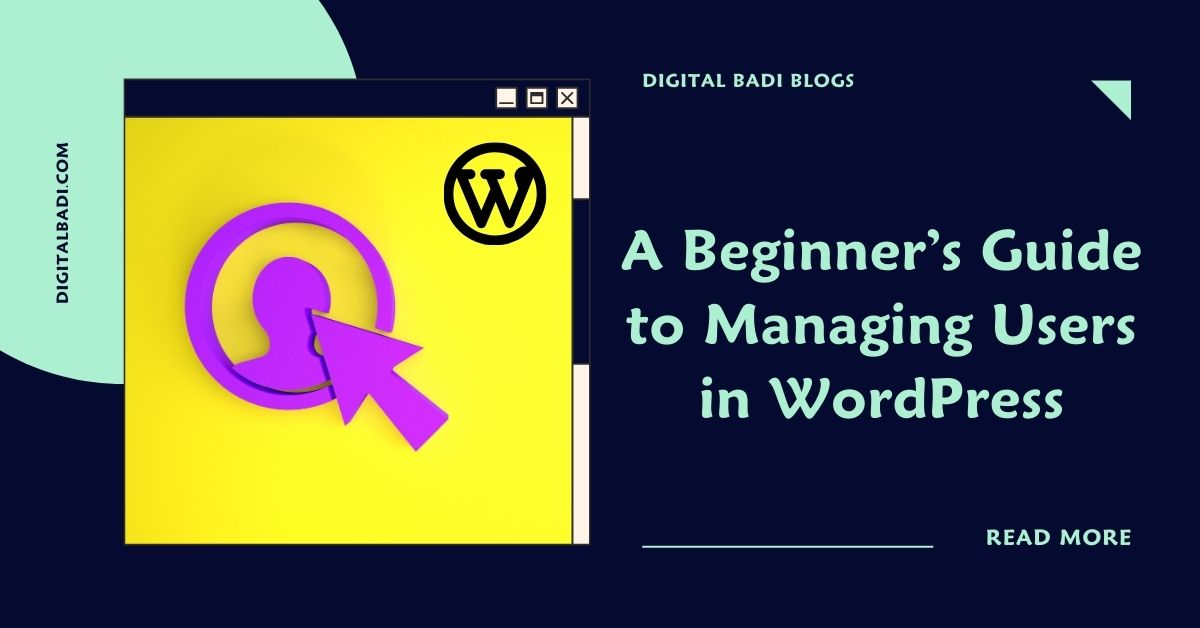
Table of Contents
Managing Users in WordPress
One of the key advantages of using WordPress for your website or application is its built-in user management capabilities. Handling user accounts, roles, permissions, and profiles are essential for many sites.
Managing Users in WordPress:- You can assign roles, which was designed to give the site owner the ability to control what users can and cannot do within the site. There are different roles to explore, and each role is allowed to perform a set of tasks.
Whether you want to enable user logins for membership sites, allow staff authors to publish content, or secure admin access, WordPress provides the core user tools you need.
In this beginner’s guide, we’ll explore WordPress user management covering:
- The different default user roles and permissions
- How to add/remove/edit user accounts
- Setting user capabilities and restrictions
- Plugins for advanced user functionality
- Securing user data and passwords
- Customizing user profiles and dashboard
Let’s see how WordPress empowers you to easily handle users without coding expertise.
Understanding WordPress User Roles
WordPress includes predefined user roles that each come with certain permissions and capabilities. The main default roles are:
- Super Admin – Top-level administrative access to the network in multisite installs. Full capabilities for all sites.
- Administrator – Total access and control of the site, including deleting/managing all content, users, settings etc.
- Editor – Can publish, manage, and edit all content but not manage users or site-wide settings.
- Author – Basic users who can submit and edit their own posts but not publish posts from others.
- Contributor – Submit and edit their own posts but cannot publish them. Posts require review first.
- Subscriber – Basic access mainly to leave comments. Cannot submit content. Role for general site members.
Understanding these common WordPress user roles helps assign appropriate permissions. Roles are covered more below.
Adding and Managing User Accounts
You manage all user accounts from the Users menu in the WordPress dashboard. Here you can:
- Add new users by entering their email, username, password etc.
- Search/browse existing users
- Edit user details by clicking on a username
- Delete users completely
- View and modify role assignments
Bulk actions allow managing multiple users at once like resetting passwords or deleting accounts.
Segmentation with user roles prevents conflicts – authors can’t overwrite published content for example. Restrict contributors to only submitting drafts for review before publishing.
Configuring User Roles and Permissions
Beyond the main default user roles, you can customize user capabilities and permissions even further:
- Use plugins like User Role Editor to configure advanced role definitions not possible in core WordPress.
- Change permissions of existing roles at Users > Roles like limiting image uploading for certain users.
- Remove default roles like Author or Contributor if not needed. Keep roles minimal.
- Create customized roles for niche access levels using role management plugins.
- Allow only approved users to register rather than open registration if needed.
Fine-tuning roles to match your site’s user structure results in better security and user experience. Don’t overwhelm users with unnecessary permissions.
Extending User Functionality With Plugins
WordPress user management basics enable covering many common user scenarios. But for advanced needs, user-related plugins extend possibilities like:
- Membership plugins for subscription access sites like MemberPress and PaidMemberships Pro.
- Custom registration/login forms to match site design rather than generic WordPress forms.
- Social login plugins so users can register/login via Google, Facebook etc.
- Multi-factor authentication plugins for extra login security.
- User tracking tools to monitor activity and behavior.
- Private messaging plugins for user-to-user communication.
The WordPress plugin ecosystem provides specialized user functionality for sites requiring advanced membership management, social features, ecommerce, and more.
Securing User Data and Passwords
When managing users, ensuring security is critical. Some tips:
- Require strong passwords – enforce minimum length and complexity.
- Use two-factor authentication methods like security keys or one-time access codes.
- Install a security plugin like Wordfence to block suspicious activity.
- Limit login attempts to deter brute force attacks.
- Use HTTPS and SSL certificates to encrypt transmitted user data.
- Only collect necessary user information and safely store it.
With security measures in place, users can have peace of mind that their account and personal details remain protected.
Customizing User Profiles and Dashboard
Tailoring the user experience is also key. Options for this include:
- Modify user dashboard design using hooks or a plugin like Ultimate Dashboard.
- Add custom profile fields so users can share extra info publicly or privately.
- Use plugins to provide user avatars and badges/ranks for engagement.
- Create customized templates for user directory listings.
- Allow users to manage notifications and email preferences.
- Provide easy password reset and account management self-service flows.
A refined user experience encourages engagement, satisfaction, and retention over time.
Conclusion
Managing users is essential for many WordPress sites like membership portals, news outlets with multiple authors, and ecommerce stores.
Luckily, WordPress provides intuitive core user tools covering user account administration, predefined roles, permissions customization, and data security fundamentals.
For advanced user functionality, take advantage of membership, social login, messaging, and other specialized plugins available.
By leveraging these WordPress user management features, you can create tailored user experiences that securely serve your site’s needs and scale as you grow. Restrict access where required while enabling users productively through their dashboard.
The possibilities are vast. With some thoughtful user management and the help of plugins, WordPress can handle everything from a simple blog to a sophisticated user community.

Rakesh Bandari is a veteran digital marketer with over 5 years of experience in Digital marketing and now he comes out with the brand “Rakesh Ranks”
WordPress
A Beginner’s Guide to Handling Images, Videos, and Media in WordPress
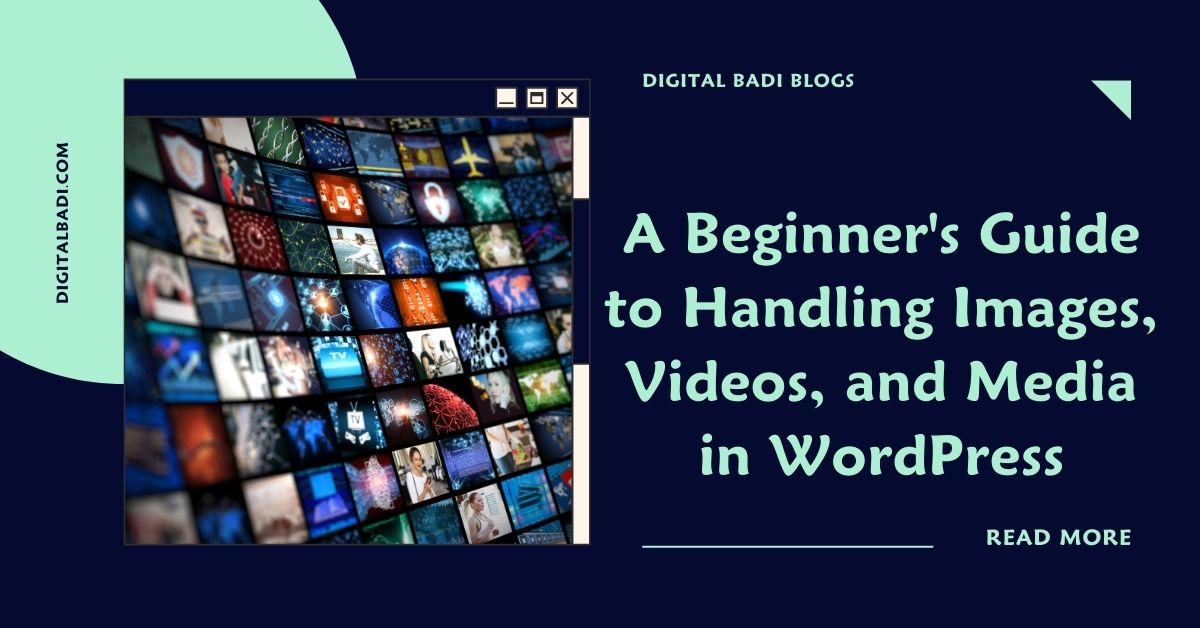
Table of Contents
Beginner’s Guide to Handling Images,Videos,and Media in WordPress
An effective website involves more than just text content. Images, videos, audio clips, PDF documents, and other media elements help create engaging pages that visitors love.
WordPress makes it easy to add diverse media when creating posts and pages. But organizing, managing, and optimizing all the media across your site requires some knowledge.
In this beginner’s guide, we’ll explore how WordPress supports media through:
- Uploading media into the library
- Inserting media into content
- Media management tools and optimization
- Creating image galleries and sliders
- Videos, audio, and other media support
- Handy media plugins
Let’s look at how WordPress empowers you to make media a valuable part of your site without complexity.
Uploading Media to the Library
The first step in adding visual and audiovisual elements is uploading the media files to your WordPress site. The media library serves as a central repository for all media.
To upload media:
- Navigate to Media > Add New in your WordPress dashboard.
- Drag and drop files from your computer into the uploader window or click to select them.
- Once uploaded, media files appear in the media library for easy discovery and reuse.
Supported file types include common formats like JPG, PNG, GIF, MP4, MOV, MP3, PDF, and more. The uploader makes adding any media you create or capture easy.
Inserting Media Into Your Content
Once uploaded into the media library, adding media into your pages, posts, and custom post types is simple.
When editing a post, click the Add Media button. Select a file from the media library popup to embed it.
You can insert media:
- As inline image or video in a content block
- In an image gallery or playlist block
- As a featured image highlighted at the top
- In a sidebar or text widget
- As a header or background image through custom CSS
Drag and drop reordering changes the sequence. The text editor makes inserting any media into content intuitive.
Organizing Your Media Library
As your media library grows, keeping it organized is key for efficiency. Helpful ways to manage media include:
- Using categories – Assign media files to different categories like Logos, Product Photos, Staff Headshots, etc. to group similar items.
- Adding descriptions – Enter a description summarizing the media like “John Doe employee headshot” for quicker searching.
- Deleting unused media – Delete any unused media periodically to keep the library clean and avoid clutter.
- Renaming files – Give media filenames that summarize contents rather than default names from cameras.
- Choosing thumbnail sizes – Select image thumbnail size under Media Settings matching your intended use like large or thumbnail.
Taking time to apply these organization tips will help you locate and reuse media assets faster.
Media Optimization
Optimizing media ensures it loads quickly and serves users well. Key optimization tips:
- Compress oversized images – Use tools like Compressor.io to reduce image file sizes without noticeably impacting quality.
- Lazy load images/videos – Load media only when scrolled into view with plugins like BJ Lazy Load.
- Downsize thumbnail dimensions – Set thumbnail widths/heights to values appropriate for your site design (ex: 250x200px)
- Use auto formatting – Check “Remove EXIF Thumbnail Data” under Media Settings to strip unnecessary metadata.
- Add ALT text – Provide descriptive ALT text for accessibility and SEO.
Optimized media doesn’t bog down site loading times while improving user experience.
Building Image Galleries
WordPress makes creating engaging image galleries easy through:
- Gallery block – Select multiple images when editing a post and choose Gallery from the block inserter to automatically create a gallery. Customize layout, captions etc.
- Media library galleries tab – Generates instant galleries from selected media library images. Customize and embed into posts.
- ** Gallery plugins** – Options like Envira, Modula and FooGallery add gallery creation tools directly in the editor. More custom layouts and functionality.
Image galleries allow showcasing products, portfolio projects, event photos, and other collections in style!
Embedding Video and Audio Content
WordPress supports embedding common video and audio formats like YouTube, TikTok, Spotify, Podcasts, and more by copying and pasting their embed code or URLs directly into the editor.
Key benefits of embedded media:
- Video platforms handle hosting and serving the files.
- Content remains visible to search engines unlike attached media.
- Formats like YouTube are mobile responsive.
- Options to autoplay media, show related content, etc.
For audio, podcast platforms like Buzzsprout provide embed codes to easily add podcasts to posts and pages.
Even More Media Possibilities!
In addition to the basics we’ve covered, there are plugins providing advanced media features like:
- Slideshow/carousel plugins – Add eye-catching responsive slideshows and carousels for image/video galleries.
- PDF plugins – Embed PDFs directly into pages, create download links, etc.
- Lightbox plugins – Display enlarged media in pop-up lightboxes when clicked.
- Watermarking plugins – Automatically add watermarks like your logo to every image.
- GIF support – Animate posts and pages by inserting animated GIFs.
WordPress empowers you to incorporate all kinds of media into your content without hassle!
Conclusion
Media elements are critical for engaging websites, and WordPress provides user-friendly tools for managing everything from images to videos seamlessly.
Easily upload media to the central library, insert into posts and pages, organize and optimize assets, create galleries and playlists, embed audio and video, and extend functionality through plugins.
Rather than struggling with cumbersome attachments or external media platforms, let WordPress handle the heavy lifting so you can focus on creating compelling websites enhanced by media.
The next time you want to illustrate a blog post with photos or share an exciting video highlight, leverage the media power built into WordPress. Your multimedia site awaits!

Rakesh Bandari is a veteran digital marketer with over 5 years of experience in Digital marketing and now he comes out with the brand “Rakesh Ranks”
-

 Digital Marketing2 years ago
Digital Marketing2 years agoTraditional Marketing vs Digital Marketing
-

 Telugu Blogs2 years ago
Telugu Blogs2 years agoడిజిటల్ మార్కెటర్ కి ఉండాల్సిన స్కిల్స్ ఏంటి?
-

 Telugu Blogs2 years ago
Telugu Blogs2 years agoడిజిటల్ మార్కెటింగ్ నేర్చుకోవడం ఎలా ?
-

 Graphic Designing2 years ago
Graphic Designing2 years agoCareer Opportunities in Graphic Designing
-

 Digital Marketing2 years ago
Digital Marketing2 years agoStory of Rakesh Bandari (Rakesh Ranks)
-

 Telugu Blogs2 years ago
Telugu Blogs2 years agoప్రీలాన్సింగ్ ద్వారా ఆన్లైన్లో డబ్బులు సంపాదించడం ఎలా?
-

 Digital Marketing2 years ago
Digital Marketing2 years agoSearch Engine History
-

 Video Editing2 years ago
Video Editing2 years agoCareer Opportunities in Video Editing

